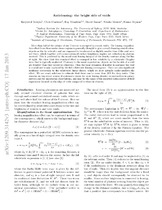| dc.contributor.author | Bolejko, Krzysztof | |
| dc.contributor.author | Clarkson, Chris | |
| dc.contributor.author | Maartens, Roy | |
| dc.contributor.author | Bacon, David | |
| dc.contributor.author | Meures, Nikolai | |
| dc.contributor.author | Beynon, Emma | |
| dc.date.accessioned | 2018-02-06T10:39:35Z | |
| dc.date.available | 2018-02-06T10:39:35Z | |
| dc.date.issued | 2013 | |
| dc.identifier.citation | Bolejko, K. et al. (2013). Anti-lensing: the bright side of voids. Physical Review Letters, 110(2): 021302 | en_US |
| dc.identifier.issn | 0031-9007 | |
| dc.identifier.uri | http://dx.doi.org/10.1103/PhysRevLett.110.021302 | |
| dc.identifier.uri | http://hdl.handle.net/10566/3475 | |
| dc.description.abstract | More than half of the volume of our Universe is occupied by cosmic voids. The lensing magni ca-
tion e ect from those under-dense regions is generally thought to give a small dimming contribution:
objects on the far side of a void are supposed to be observed as slightly smaller than if the void were
not there, which together with conservation of surface brightness implies net reduction in photons
received. This is predicted by the usual weak lensing integral of the density contrast along the line
of sight. We show that this standard e ect is swamped at low redshifts by a relativistic Doppler
term that is typically neglected. Contrary to the usual expectation, objects on the far side of a void
are brighter than they would be otherwise. Thus the local dynamics of matter in and near the void
is crucial and is only captured by the full relativistic lensing convergence. There are also signi cant
nonlinear corrections to the relativistic linear theory, which we show actually under-predicts the
e ect. We use exact solutions to estimate that these can be more than 20% for deep voids. This
remains an important source of systematic errors for weak lensing density reconstruction in galaxy
surveys and for supernovae observations, and may be the cause of the reported extra scatter of eld
supernovae located on the edge of voids compared to those in clusters. | en_US |
| dc.language.iso | en | en_US |
| dc.publisher | American Physical Society | en_US |
| dc.rights | This is the pre-print (from arXiv: 1209.3142v3) of the article that can be found online at: http://dx.doi.org/10.1103/PhysRevLett.110.021302 | |
| dc.subject | Cosmic voids | en_US |
| dc.subject | Lensing magnification | en_US |
| dc.subject | Relativistic linear theory | en_US |
| dc.subject | Clusters | en_US |
| dc.title | Anti-lensing: the bright side of voids | en_US |
| dc.type | Article | en_US |
| dc.privacy.showsubmitter | FALSE | |
| dc.status.ispeerreviewed | TRUE | |
| dc.description.accreditation | Web of Science | |

